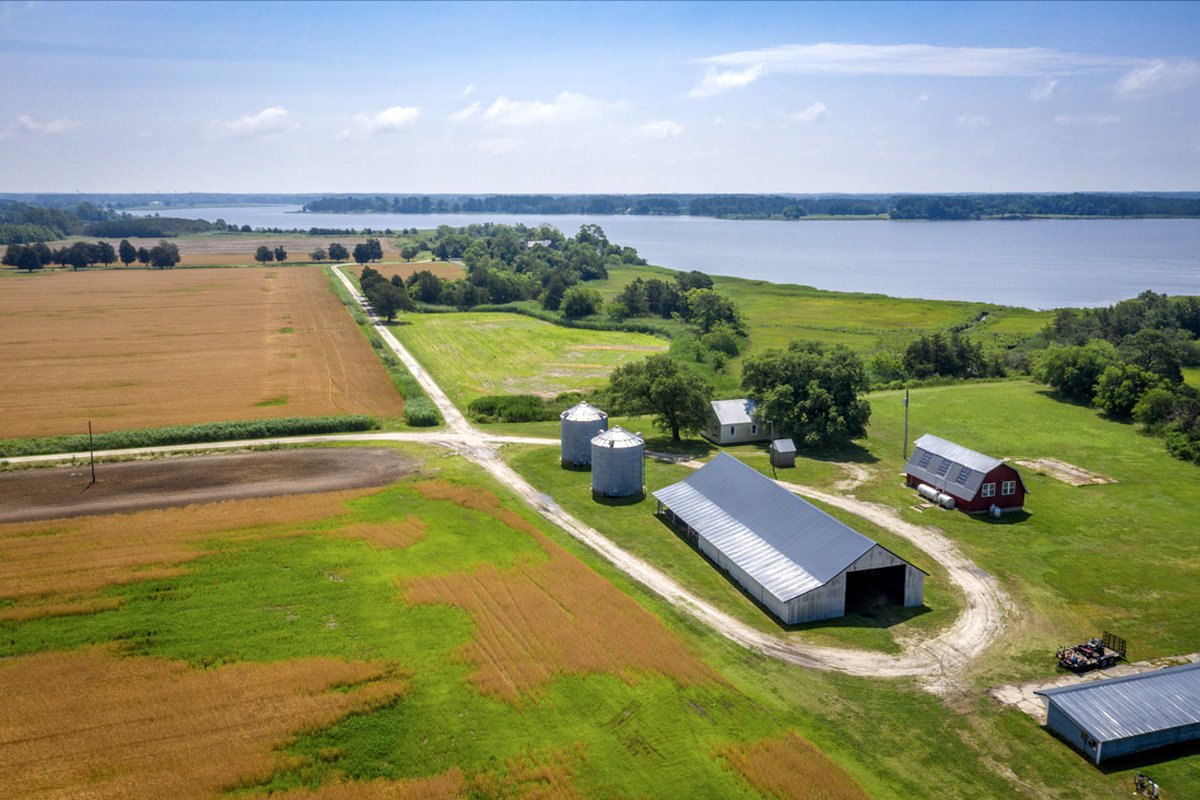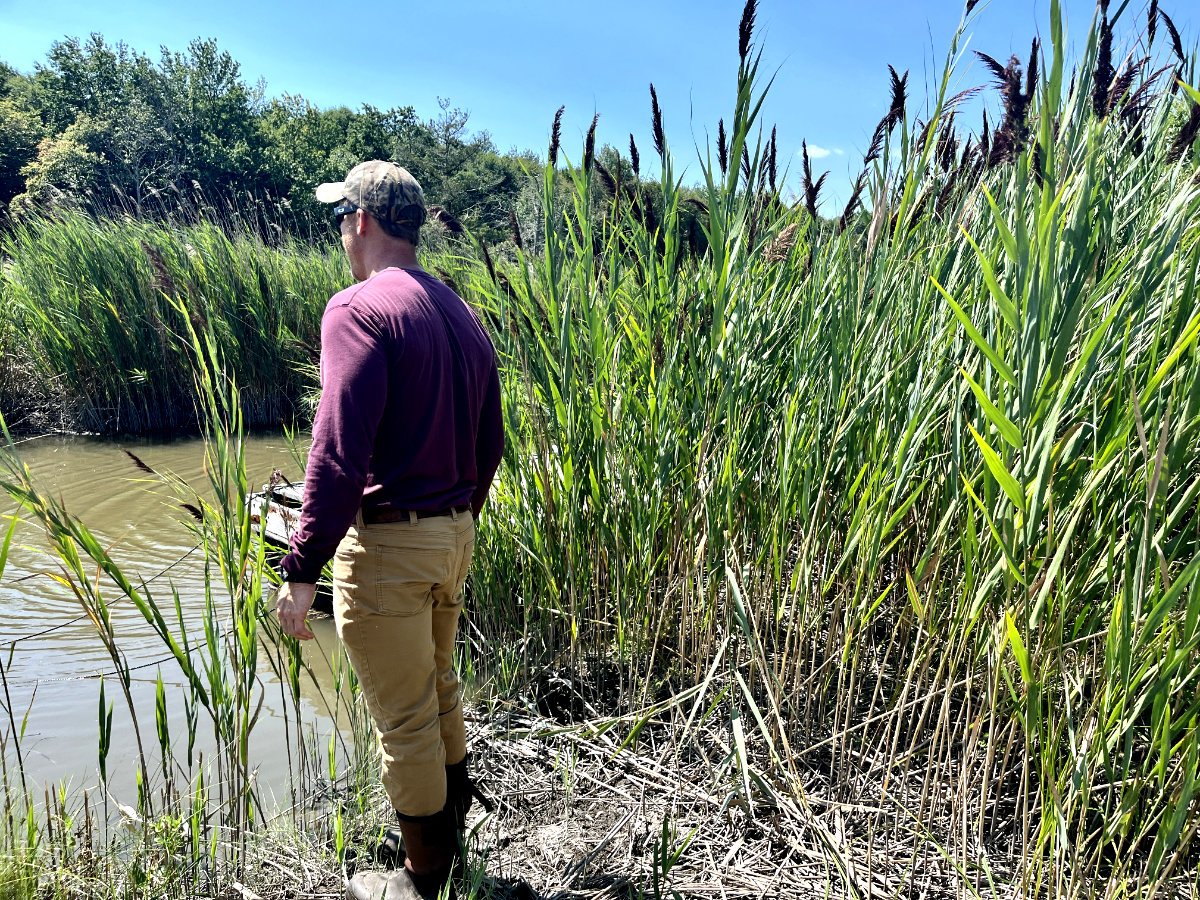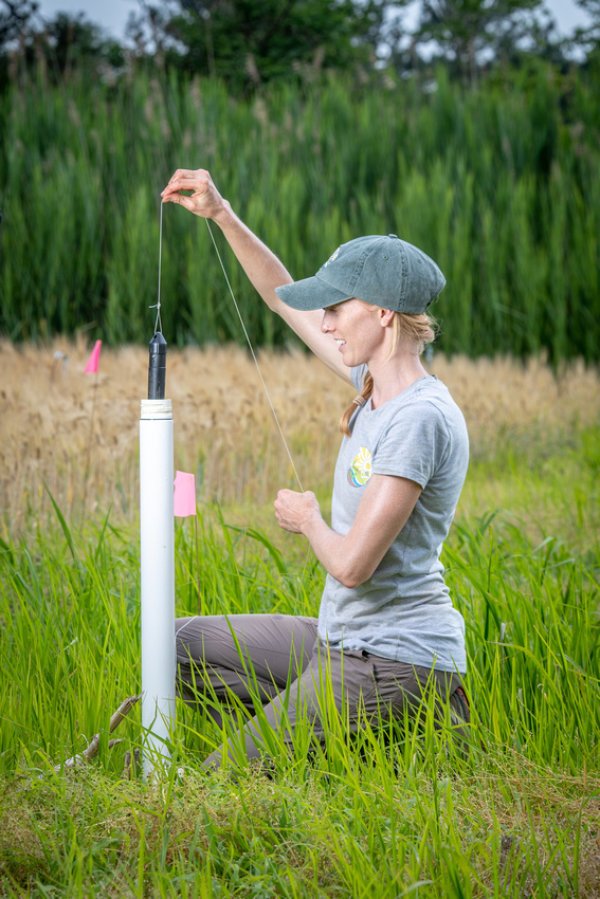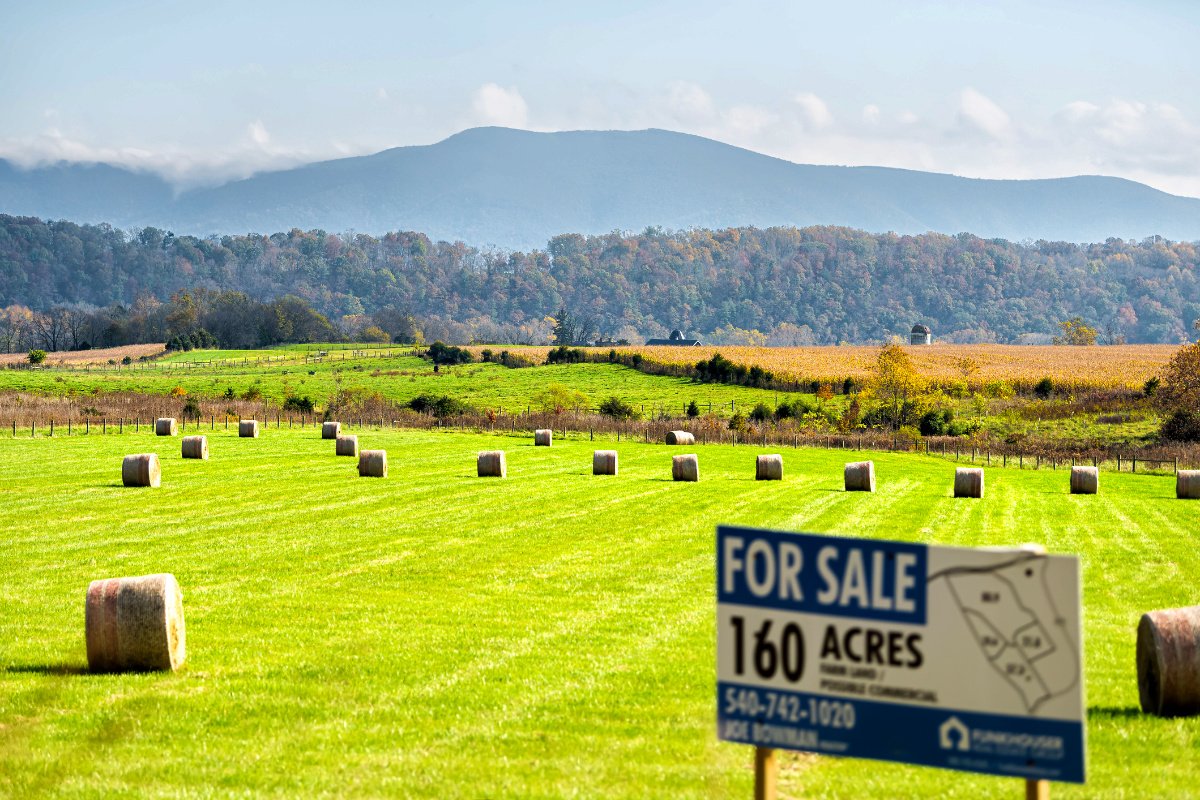In the Mid-Atlantic, sea level rise due to climate change is already changing what farmers can grow.

In the Mid-Atlantic, sea level rise due to climate change is already changing what farmers can grow.
January 15, 2024

An example of saltwater intrusion on the Delmarva peninsula. (Photo credit: Edwin Remsberg)
John Zander’s family has owned a stretch of land along New Jersey’s southern coast for 30 years, but he only recently dubbed the farm “Cohansey Meadows.” Cohansey for the river that runs through it. Meadows for the term that residents of the region use to refer to the vast marshes that create a fluid transition between solid ground and the water of the Delaware Bay.
“This portion is a field, this portion is woods, this is marsh—it’s kind of all intertwined,” he explained while walking a road that August rains had turned to mud. In a nearby wooded area, insects hummed. In an open space where grasses stretched to the shoreline, ospreys flew overhead, dangling fish in their talons.
For decades, his family used the marshes for muskrat trapping and duck hunting and leased the drier land to farmers who grew corn and soybeans. But as salty water from the bay began to encroach, he realized they’d have to reimagine what the land could provide.
“As far as commercial production of corn and soy, it’s probably not viable anymore,” Zander said. As a result, he’s been asking himself, “What can we grow in these really harsh conditions? How can we turn this into an advantage?”

John Zander, project manager at Cohansey Meadows Farms in Fairfield Township, New Jersey. (Photo credit: Mattie Cameron Rosen, NJ Spotlight News)
With the help of state grant money, Zander will be planting test plots of various tidal grasses. Unlike most crops, the grasses don’t mind being submerged and can hold salt in their roots and excrete it through glands in the blades. During storms, their dense root system slows down encroaching flood water, helps the land absorb more of that water, and prevents erosion. He plans to harvest some grasses as hay for animal bedding and weed control. The rest he’ll sell as “plugs” to other farmers to plant their own field buffers and to conservation groups for wetland restoration projects.
While the markets for these grasses are barely established, it’s one potential solution to a clear problem: In the coming years, as the effects of climate change intensify, growers in this and other coastal regions will have to farm differently. What exactly that will look like is still developing and it will likely include growing new crops in new places. Zander’s crop of choice is novel because not only can he grow tidal grasses on land where saltwater is moving in, but he can then sell them to be planted in other places to rebuild wetlands and create field buffers, protecting other farm landscapes from the same fate.
“What can we grow in these really harsh conditions? How can we turn this into an advantage?”
States further south, such as Florida, have been dealing with the phenomenon known as “saltwater intrusion” for much longer, and Louisiana has recently faced the high-profile threat of it disrupting drinking water supplies. But farmers in the Mid-Atlantic are likely to see it more often in the coming years. The region has been identified as a current and future hotspot, explained Chris Miller, a conservation agronomist who runs the U.S. Department of Agriculture’s Cape May Plant Materials Center, about 40 miles east of Cohansey Meadows on New Jersey’s Atlantic coast.
Scientists at the National Oceanic and Atmospheric Administration (NOAA) predict that sea levels along the East Coast will rise by about a foot over the next 30 years. Exactly how far inland the salt encroaches will depend partially on how effective humans are at reducing greenhouse gas emissions, as rising temperatures and melting ice sheets are the main contributors to the ocean’s expansions.
In July, a team of researchers led by Kate Tully at the University of Maryland published a paper that mapped the extent of saltwater intrusion onto Delaware and Maryland farmland on the Delmarva Peninsula for the first time. The peninsula is a low-lying land mass between the Chesapeake Bay and the Atlantic Ocean, where farmers growing corn and soy for chicken feed increasingly find patches of their fields white-washed with salt. According to the researchers, between 2011 and 2017 the number of visible salt patches almost doubled and about 20,000 acres of farmland turned into marsh.
“Even though it’s still a relatively small amount of cropland that’s currently impacted by salt, it’s increasing exponentially because sea level rise is increasing and the number of storms we’re getting is increasing and the intensity of storms we’re getting is increasing,” Miller said of the region.
New Jersey’s farms, just to the north, have not yet seen this degree of impact, and the U.S. Geological Survey is still working on quantifying the problem in the state. But people like Zander and Miller are working to establish systems that work as they watch the issue manifest in real time on the ground. “I hunt, I trap, and I’m also a conservationist. I know the habitats. I walk the ditches. I see the changes,” Zander said.
“If you take a soils class in college and you talk about salinity, you’re going to talk about the Dakotas and Colorado and even California,” said Jarrod Miller, an agronomy specialist at the University of Delaware (no relation to Chris). That’s because farmers in dry, Western states have long had to contend with salt in their soil. Without regular rainfall, salt from natural processes and irrigation water sticks around and builds up, threatening plant growth.
To manage it, farmers use specific irrigation methods to flush salt out of the soil or may add gypsum, which essentially displaces sodium with calcium, to their fields. They may also plant crops that can tolerate higher levels of salt: barley instead of corn, asparagus instead of carrots.

John Zander looking at water running through one part of his land with grasses behind him. (Photo credit: Lisa Held)
For the past five years, Miller has been working in the fields alongside other Mid-Atlantic researchers like Tully to try to figure out how much of that knowledge can be applied to farms in their region. One important factor is that there are many different salt compounds, and seawater is an elaborate cocktail. Another is that fields where more salt-tolerant dryland crops like barley might thrive have been hard to find.
“You have this dual issue of excess moisture as well,” said Miller, since although saltwater can also enter aquifers from below ground, most of the intrusion to date has been caused by flooding from storms and hurricanes made stronger by climate change.
As Chris Miller puts it, in the West, “They’re dealing more with the salt in the soil. We’re dealing more with the salt in the water. Plus, there’s the double whammy of plants that need to tolerate flooding periodically.”
Some farmers in the region have taken to using dikes and gates that prevent water from making it onto their fields. Tom Sheppard of Sheppard Farms in Cedarville, New Jersey, is using those practices for his asparagus, sweet corn, peppers, and cucumbers, which are planted just two miles away from the Delaware Bay. “After Sandy, we raised the dikes two feet because we did get breached in in one area,” he said, referring to the historic 2012 hurricane that battered the Eastern seaboard. “It didn’t hurt us, but we didn’t want to have that happen again.”
But instead of trying to keep the water at bay, Zander’s opted to look to the region’s agricultural past for inspiration, to an approach that works with the tidal landscape.

Kate Tully in the field researching saltwater intrusion on the Delmarva Peninsula. (Photo credit: Edwin Remsberg)
Since colonial times, settlers along the coast cut the dominant perennial marsh grass, spartina patens, into what they called salt hay. Over the years, the construction industry has used salt hay for insulation, livestock farmers use it for animal bedding, and berry growers mulch with it, since it is naturally free of weed seeds.
But working in a marsh is difficult, and farmers often had to wait for the water to freeze before bringing tractors out onto the ice to harvest. Zander’s idea is simple: plant the grasses a little further in, on dry land, where saltwater now encroaches occasionally, making harvesting salt hay easier.
From there, he’ll bring something even newer to the old system: harvesting whole plants to sell to organizations working to restore wetlands and to farmers who want to plant barriers along waterways to slow encroaching saltwater during storms.
At the Cape May Plant Materials Center, Chris Miller is developing knowledge and tools that will help Zander succeed.
Established in 1965, the center is dedicated to “conservation plants” and originally focused on researching plants suited to the region’s sand dunes. But over the past decade, Miller has been leading a shift toward focusing on coastal plants that can help address saltwater intrusion in agriculture. Often, the plants in question are the same, they’re just used differently.
In a greenhouse, he’s testing the salt tolerance of other cordgrasses in the spartina family. Grasses planted in a pearlite growth medium sit in trays where a system pumps in brackish water, simulating tidal flow. In a few weeks, he says, he’ll pull out the plants and measure the top growth and the root systems to determine the impact the salt is having.
Spartina patens, a salt-loving halophyte, is Miller’s standard of comparison, but he’s finding other related grasses that can thrive in a decent amount of salt. When he tested spartina pectinata, often referred to as “freshwater cordgrass,” for instance, he found it could tolerate about 15 parts per thousand compared to spartina patens’ 30. “We’re finding that many plants actually have a higher level of tolerance than what’s identified in the literature,” he said.
Outside the greenhouse, in the fields, three different tidal grasses are planted in sandy plots side by side: Avalon, named for a nearby beach town; Flageo, from North Carolina; and Sharp, from Louisiana. With climate change, he says, “we’re looking to which plants are helping solve problems in the South, because they’re probably going to be adapted here in the future, if they aren’t already.”
In this trial, he’s measuring how much biomass the three grass varieties produce, as well as the spread of their roots, and how well they perform as animal feed. One might yield more hay, while another might be better as habitat, he says, and that information will be crucial going forward. While taking markets into account is not in the Materials Center’s purview, Miller knows that whether farmers can sell the grasses they grow will be a key factor in determining whether they’ll plant them.
“We’re looking to which plants are helping solve problems in the South, because they’re probably going to be adapted here in the future, if they aren’t already.”
Just across another field from the trial plots, for instance, scientists are growing rows of seashore mallow, a bushy, salt-tolerant plant with delicate pink flowers that bloom for a single day. Miller is excited about the fact that seashore mallow is easier to propagate than some of the grasses. But researchers at the University of Delaware who worked on establishing the plant for salt-impacted farms found that it didn’t take off as an alternative crop.
Researcher Jennifer Volk said that while the team “was able to demonstrate that the mallow plant had a number of potential uses, from the seeds to the flowers to the ground-up stems, which we found to be effective as an alternative poultry house bedding, there were logistical issues with growing enough quantity of the crop in our region to develop viable markets.”
Miller and Zander are most focused on markets that are emerging to support conservation, both of the farms that are threatened by the changing climate and the ecosystems that surround them. If Zander can grow hundreds of acres of a variety of salt-tolerant grasses, he’ll be able to provide the plants that farmers growing grains and vegetables need to create barriers between the encroaching saltwater and their crops.
“We’re hoping that more and more farmers will embrace this whole idea of buffers, particularly if they can’t grow a crop on that particular land,” Miller said.
And Zander is watching closely as state and federal money flows to wetland and coastal restoration projects that aim to reduce erosion control and hold back seawater. Many of them will need plants, and he’s committed to growing them.
If it all works out, a situation born of the climate crisis could produce an array of benefits for the farmer. While his crops aren’t edible, they could protect others’ edible crops while improving water and air quality in the region and providing wildlife habitat. At Cohansey Meadows, he counts the bald eagle nests each year as the numbers tick up gradually.
“I feel so connected to the land here,” Zander says, pointing out the spot in the meadow where his son caught his first muskrat. “I really view myself as part of the whole puzzle.”
This article was produced in partnership with New Jersey Spotlight News. See below for a video report on the topic:

October 9, 2024
In this week’s Field Report, MAHA lands on Capitol Hill, climate-friendly farm funding, and more.
October 2, 2024

October 2, 2024

October 1, 2024

September 24, 2024

September 18, 2024

Like the story?
Join the conversation.